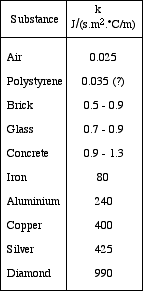
Heat is a form of energy - specifically - the average kinetic energy of atoms in random motion (gases), or in vibrational motion (solids). Energy is transferred to nearby atoms by forces between atoms. Heat can be said to 'flow' in this sense.
Heat flow through a uniform body, of uniform cross section, is governed by the cross sectional area A, length Dx, thermal conductivity k, and the temperature difference between the ends, DT.
These observations are expressed as a single equation for heat flow in Joules per second, verified by experiment.

The minus sign is inserted to indicate that the heat flow is from the high temperature to low temperature. The coefficient of thermal conductivity k has units of....
Tables of thermal conductivity k, are published in a variety of units.
Thermal conductivities [MKS units]

Air is a poor conductor of heat. Building materials such as glass and bricks are similar. Windows in buildings transfer large quantities of heat because they are much thinner than walls. A one meter square window that is just 3 mm thick transfers an alarming amount of heat into or out of a building. Double glazing replaces the thin window with a thicker layer of less conductive air. Metals, with conduction electrons, are good conductors of both electricity and heat.
The highest metal conductivities are for copper and silver. Diamond, with a strongly bonded covalent structure, is the best heat conductor of all. For the conductivities of more common materials try....
http://hyperphysics.phy-astr.gsu.edu
Air is a poor conductor. Wearing a 'string singlet', (a T-shirt of what looks like fish net made from thick soft string), is a good way to keep warm in a cold climate. The holes in the net trap a layer of air next to the skin. Thick woolen clothes and blankets act in the same way - trapping air. In a crisis look for a poor conductor.
 The photograph
shows forsythia bushes flowering after a cold winter, somewhere
in northern USA. The photograph
shows forsythia bushes flowering after a cold winter, somewhere
in northern USA. |
The bushes are flowering below what was the depth of the winter snow. The conductivity of dry snow is a remarkable 0.00026 J/(s.m2°C/m). The bushes were damaged by cold only above the snow line.
Hint - if you get stuck up a mountain in a blizzard, dig a snow cave and get in. Japanese tourists did that some years ago in NZ. The army party on the same mountain died. The tourists walked out a week later. Hungry, but alive and well.
Glass has about the same thermal conductivity as brick or concrete, but, being the thinnest part of a wall, windows transfer the most heat per square meter.
Room 214 at ISB has large windows along one wall. The heat transfer to the room through the closed windows on a typical day can be calculated by estimating finding the area, the thickness of the glass and by measuring the temperature difference which is close to 10°C. (A surface temperature probe is on order from Vernier. The temperature measurement will be refined in the near future.)
The heat flow through the windows is large and expensive. In cold climates the inside-outside temperature difference can be much larger than it is in the tropics. Double-glazing [two panes of glass separated by an air gap] is the usual solution for heat insulation with the added advantage of noise reduction.
To calculate the possible advantage of double-glazing in the Lab at ISB we proceed as follows.
a Design windows with 4 mm glass and a space between and note that heat transfer across each layer is the same.
b Find the two internal temperatures T2 and T3.
c Calculate the heat flow through the inner section.
The photo shows a retired chap in Christchurch, New Zealand, enjoying the result of retrofit double-glazing. Inside temperature 24°C, outside temperature 4°C.
The chilling truth about New Zealand houses is that they are - by world standards - cold. Very cold. The climate is not life threatening as it was in Aberdeen, or Yorkshire where many of the early European settlers came from, in ship loads, from 1840 onwards. They could not believe their luck. They built cheap wooden houses, put in a fireplace, or two, and that was that. Their modern, city-living, descendants are now doing something about it, retrofitting double glazing.
The cost of a good job on all the windows of an average four-bedroom house is around $5000 US. With heating costs of around $100 US per month for the five winter months the capital cost takes some time to recover, but the comfort is considered worth the effort.
The typical inside temperature in an uninsulated house is 5°C in the morning before anyone gets up, rising to 13°C by the evening. [13°C was 'room temperature' in the English Chemistry texts used in NZ schools in the 1960's.] Insulated New Zealand houses are generally heated to 18°C, or, in more wealthy suburbs, to 23-24°C.
Question
Take the outside temperature as 4°C. The cost of heating a room to 24°C without double glazing is $80 US per month.
What would you need to know so that you could estimate the savings to be made by double-glazing, if the inside temperature is to be maintained at 24°C.
A Bangkok photographer is using a house in Moobahn Popsok as a dark-room and photographic studio. The room he keeps his negatives, film, and prints in, is to be air conditioned to 24°C, day and night. The room is square, 4m x 5m with a window area of 6 square meters.
Question
Estimate the percentage that may be saved in air conditioning costs, by double-glazing. List any assumptions you make.